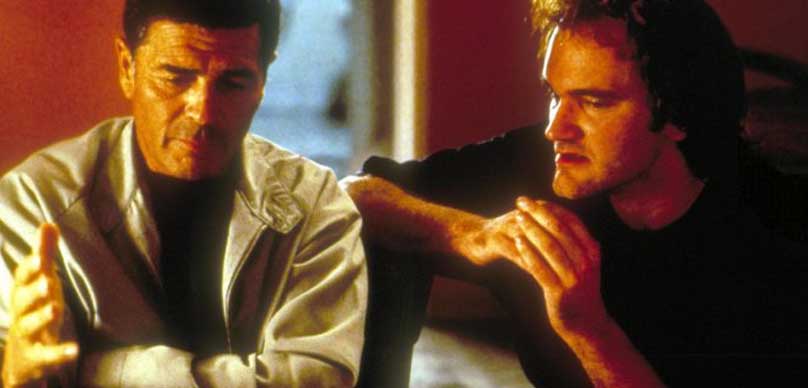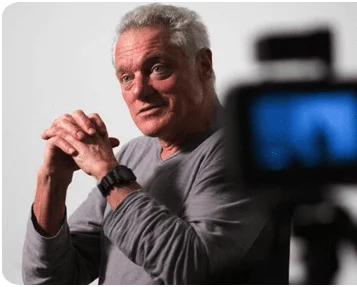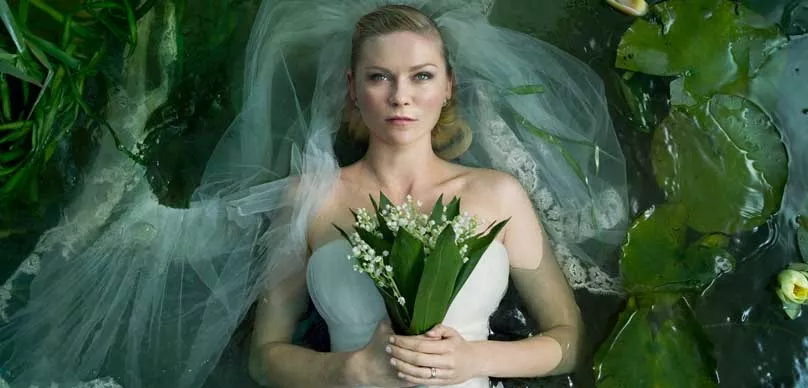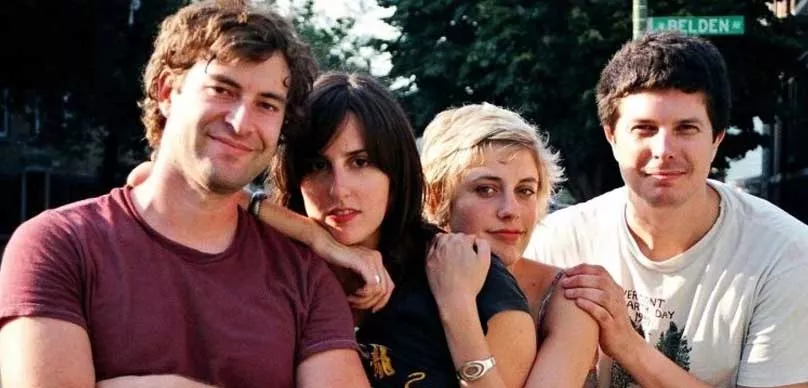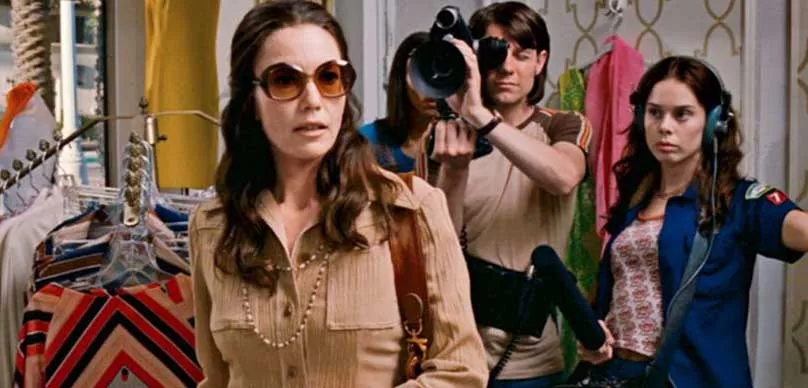Three years after his breakout hit, PULP FICTION (1994), set the cinema on fire, director Quentin Tarantino returned with a follow-up feature that again confounded his audience’s expectations. Primarily known for directing his own material, Tarantino found himself adapting pre-existing material for the first time.
He had always been a fan and kindred spirit of author Elmore Leonard, and found in Leonard’s novel “Rum Punch” the inspiration for what he would come to call “his take” on the Blaxploitation genre. The result was 1997’s JACKIE BROWN, a solid and surprising film that was met with modest commercial success, a warm critical reception, and indisputable proof that Tarantino wasn’t a one-trick pony.
You can read all of Quentin Tarantino’s Screenplays here.
JACKIE BROWN tells the story of the titular character, played by 1970’s blaxploitation icon and sex symbol Pam Grier. Jackie is an aging career criminal, down on her luck and trying to save up legitimate money for retirement on her paltry airline stewardess salary. To make ends meet, she smuggles cash for arms dealer Ordell Robbie (Samuel L. Jackson) across international borders. When she’s caught by agents from the Alcohol, Tobacco, and Firearm Bureau, she strikes a deal to help the ATF catch Ordell in exchange for her freedom. An elaborate sting involving marked bills and a Torrance shopping mall is devised, drawing in aging bounty hunter Max Cherry (Robert Forster) and schlubby ex-con Louis Gara (Robert DeNiro) into the complicated plot.
Emboldened by John Travolta’s career resurgence in the wake of PULP FICTION, Tarantino runs with the idea of stocking his JACKIE BROWN with aging (yet still excellent) performers that have seen better days. Pam Grier is a revelation as the titular heroine. She’s a former sex symbol that is unafraid to show her age, which gives her the perfect amount of gravitas for the role of a weary stewardess with a con-man’s disposition. It’s easily the best performance of her career, and I’m uncertain that any director will ever again use her as well as Tarantino does here. While she didn’t exactly go on to accumulate more work in the wake of JACKIE BROWN’s modest success, her profile was raised considerably as was the level of professional respect afforded to her.
Venerable character actor Robert Forster also became a beneficiary of Tarantino’s “Travolta Effect” when he signed on to play the role of Max Cherry, the bounty hunter with a heart of gold. Forster has certainly seen better days—a fact that Tarantino emphasizes with every close-up, revealing entire canyons of wrinkles etched into the man’s face like dry riverbeds. Max Cherry is an honorable, decent, and good man whose judgment is compromised by his love for Jackie Brown, but he never approaches anywhere near unlikeable because of it. He gives the film a paternal presence that elegantly counters Grier’s feisty persona. Tarantino had always been fond of Forster as an actor and used his powers of cultural persuasion for good once again to make us remember Forster’s subtle, compelling talent for eons to come.
Samuel L. Jackson, in his second consecutive Tarantino appearance, plays the film’s main heavy—the inimitable, ratty-ponytailed arms dealer Ordell Robbie. There seems to be a thing with Jackson and having creepy/weird hair in his collaborations with Tarantino, because the style he rocks in JACKIE BROWN makes me all kinds of uneasy. Ordell is a cold-blooded psychopath who commits murder in the name of his business interests, and there is simply no other actor on earth that can convey that kind of charismatic menace. Jackson plays the character like a classic Blaxploitation antagonist, albeit updated with a Kangol hat and a 90’s sensibility.
Similar to Bruce Willis’ inclusion in Tarantino’s previous film, it must have been a dream come true for a director profoundly influenced by Martin Scorsese to sign an actor like Robert DeNiro to his film. DeNiro, who spent much of the late 90’s and 2000’s taking uninspired paycheck roles, gives one of his best performances in years as the fu-manchu’d ex-con Louis Gara. DeNiro wheezes and mumbles his way through his performance, giving off the impression of a weary tough guy who’s content living out the rest of his days as a total slob. The veteran actor does a great job amping up the sleaze by going for broke with his greasy, unkempt hair and prison tattoos peeking out from underneath baggy Hawaiian shirts. It’s a deeply funny and macabre performance that shows us a side of DeNiro we’ve never seen before.
Michael Keaton also turns in one of the best performances of his career as ATF agent Ray Nicolette. He assumes a gum-smacking nervous energy as a man who thinks he’s cooler than he actually is. It’s an inspired, left-field casting choice on Tarantino’s part, but then again so was Keaton for Batman in Tim Burton’s 1989 film of the same name. Keaton steals every scene he’s in, which says a lot when he’s up against the likes of Grier, Jackson or DeNiro. What makes Keaton’s participation even more charming is the fact that he reprised the role a year later in another Elmore Leonard adaptation (Steven Soderbergh’s OUT OF SIGHT), as a good-natured nod to Leonard’s wider literary universe.
When you’ve got a starring cast primarily composed of character actors, it stands to reason that the supporting cast might get overshadowed. However, the supporters of JACKIE BROWN hold their own against their leading counterparts. Bridget Fonda adopts the perfect beach bunny/stoner affectation as Melanie, Ordell’s Hermosa Beach girlfriend (he’s got them all around town). Chris Tucker gives, frankly, his best performance ever as Beaumont, a petty criminal and squirrelly character that finds himself on the wrong side of Ordell’s good graces. And finally, Rob Zombie mainstay and veteran exploitation film actor Sid Haig has a brief cameo as the judge at Jackie Brown’s trial—a nice nod to the long list of films they’ve done together.
Right off the bat, most people will notice how visually sedate JACKIE BROWN is compared to PULP FICTION or RESERVOIR DOGS (or even his later work, for that matter). That’s not to say that the film isn’t visually dynamic, but it deals in metaphorical shades of grey, rather than stark black and white. Working again with his regular producers Lawrence Bender and the Weinstein Brothers, Tarantino has a significantly-sized tool chest to pull from, but he opts for a restrained, mature approach. Foregoing his usual cinematographer, Andrzej Sekula, Tarantino instead has hired Guillermo Navarro, who brings a naturalistic look to the proceedings. Gone are the burned-out Technicolor hues of Tarantino past—JACKIE BROWN’s 35mm film image boasts an earth-toned color palette, peppered with bold swaths of reds, blues, greens, and yellows that harken back to the colorful Blaxploitation films that inspired it. Returning production designer David Wasco helps translate Tarantino’s San Fernando Valley burnout aesthetic to the inner industrial wastelands of central LA. The predominantly warm color scheme of the film further plays into the 1970’s vibe, along with the incorporation of other stylistic relics of the era, like parallel action shown in split-screen and punchy, detail-filled insert shots.
Camera movements and pacing are a huge component of Tarantino’s style, and JACKIE BROWN showcases considerable development for the young director in that regard. He has an uncanny intuition that tells him when (and how) to move a camera, and when to keep it still. This is complemented by his trusty editor Sally Menke’s keen ear for the natural rhythm or music of the scene. One example occurs early on in the movie, where Ordell has just locked Beaumont in his trunk under the auspices of rolling up on some shady arms customers with bad intentions. Once inside the car, Ordell turns on a classic soul tune that stands in stark contrast to the pitch-black events on-screen. He drives him to an adjacent vacant lot, fires a couple rounds into Beaumont, and drives away. What’s remarkable about this scene, however, is that Tarantino presents the action from an objective, omniscient point of view, whereas he usually opts for an extremely subjective angle. The camera slowly cranes from the street up over the vacant lot’s fence, where Ordell’s car and his crime are framed in the distance. Despite our emotional remove from the central action, it’s a haunting sequence because Ordell’s cold-blooded nature is emphasized even more so than if we had seen the blasts close-up. The off-tone musical selection is the coup de grace, and a textbook example of why Tarantino stands apart from his contemporaries and copycats.
Tarantino’s visual style is easily definable due to his recurring compositional conceits. There’s the well-known trunk POV shot (manifested in JACKIE BROWN prior to the aforementioned Beaumont murder scene, where Ordell squabbles with Beaumont about actually getting inside the trunk). The film also sees the introduction of another major composition conceit- the profile shot. By this, I mean his tendency to frame his characters in profile. This is seen most often in dialogue sequences, but he also uses it to striking effect in motion, such as the iconic opening of the film featuring Jackie Brown riding an LAX people-mover while a colorful mosaic of wall tiles rolls past (which is itself a reference to the same opening shot in Mike Nichols’ THE GRADUATE (1967), that time against blank white tiles). The use of profile shots points to parts of Tarantino’s aesthetic influenced not by film, but by pulp novels, Japanese manga, and comic books. These influences would go on to manifest themselves to a much larger degree in his next project: KILL BILL (2004).
While JACKIE BROWN is Tarantino’s first true linear storyline, he can’t help but incorporate nonlinear elements into the narrative. In a design inspired by Akira Kurosawa’s RASHOMON (1950)—a film about a singular event retold in the differing perspectives of its ensemble—Tarantino stages the central money-switch sting as a converging event for all the characters involved. We see the plan carried out from the point of view of each key character, and each time a little more information is revealed until we have the complete picture. Tarantino makes extensive use of long tracking shots here to convey the size of the mall location, effortlessly weaving in dialogue of peripheral characters into the ambient sound mix in a way that conveys where the current subject is on the overall timeline. It’s a showy technique, to be sure, but Tarantino resists the urge to showboat his directorial skills and lets his perspective shifts naturally build the story and the suspense.
Music plays an integral role in JACKIE BROWN, as it does in all of Tarantino’s films. While it is certainly an inspired and eclectic mix of source tracks, it is admittedly more on-the-nose than the likes of using surf rock for PULP FICTION’s pulp noir. The soundtrack throws many nods to the Blaxploitation genre by including a mix of classic R&B and soul cuts. Bobby Womack’s “Across 110th Street” in particular is used to striking effect in the opening credits, becoming the film’s de facto theme song. Some hip-hop, as well as an off-tone country ballad by Johnny Cash also makes an appearance. Unlike his previous films, there is somewhat of a score element in JACKIE BROWN, albeit it is culled from a pre-existing work: Roy Hyer’s score for COFFY (1973), a classic in the Blaxploitation genre that made Pam Grier a star.
JACKIE BROWN effortlessly crosses out each item on the Tarantino Style checklist: closeups of feet implying the director’s own admitted fetish, chapter-like inter-titles used as scene divisions, yellow-colored title fonts, long tracking shots, creative profanity, abundant pop culture references, etc. I wrote before in my analysis of FOUR ROOMS: THE MAN FROM HOLLYWOOD (1995) how Tarantino had become such a force in pop culture that he was now referencing himself. This trend continues over into JACKIE BROWN. For instance, when Jackie Brown conducts the sting operation, she purchases and changes into a feminine version of the black suit and white shirt worn by the archetypical Tarantino criminals in RESERVOIR DOGS and PULP FICTION.
There’s also a fictional “Chicks With Guns” TV program that the characters watch, which comes off as a satirical version of the way Tarantino’s films are negatively characterized by the press as violence porn.
Another interesting trope of Tarantino’s style that makes its first appearance in JACKIE BROWN is echoing a hard cut visual transition in the non-diagetic music mix. In other words, Tarantino and Menke simply cut the music without a fade or transition as the shot changes. It’s a jarring effect that traces its roots back to the innovations of the French New Wave, and I find it endlessly amusing.
Casual moviegoers might find it odd for a white man to tackle such a specific ethnic genre, but Tarantino has always been comfortable within African-American culture. By his own account, he grew up in a housing project in Tennessee shared by both blacks and whites, so he feels right at home in JACKIE BROWN’s cultural wheelhouse. This conceit is not without its problems, however. Much has been written about Tarantino’s controversial use of the “n” word, and reactions to it fall on both sides of the line—director Spike Lee loathes it, Samuel L. Jackson defends it. I’m not here to debate whether Tarantino has a right to use the word by virtue of expressing his fictional characters’ convictions, but I am here to note its significant role in his legacy. The “n” word has always lurked in Tarantino’s filmography: dropped casually/almost unnoticeably in RESERVOIR DOGS (1992), picking up steam and mild outrage when the director (acting in character) says the word himself in PULP FICTION, coming to a common, yet justifiable occurrence in JACKIE BROWN, and finally tipping the scales back into gratuitous-or-not uncertainty with its pervasive presence in Tarantino’s latest, DJANGO UNCHAINED (2012).
JACKIE BROWN occupies an interesting space in Tarantino’s filmography. Upon release it was hailed as a worthy successor to the groundbreaking PULP FICTION, with influential critics like Roger Ebert going nuts for it. It was a commercial success and kick-started the flagging careers of many of its cast. A little less than twenty years later, JACKIE BROWN has been overshadowed by the sheer bombast of his more-recent work, enough to the point where most might consider JACKIE BROWN a minor, yet solid, entry. It hasn’t aged as well as PULP FICTION has, but then again it always belonged to another dated era entirely. Among his major motion pictures, it is likely the least seen, but those who give the disc a spin are instantly charmed by its unique characters and throwback vibe. JACKIE BROWN is a love letter to a genre of films that profoundly influenced Tarantino, and this film is his way of giving back to the ideas and people that gave him so much.
Author Cameron Beyl is the creator of The Directors Series and an award-winning filmmaker of narrative features, shorts, and music videos. His work has screened at numerous film festivals and museums, in addition to being featured on tastemaking online media platforms like Vice Creators Project, Slate, Popular Mechanics, and Indiewire.
THE DIRECTORS SERIES is an educational collection of video and text essays by filmmaker Cameron Beyl exploring the works of contemporary and classic film directors.
Sponsored by: Special.tv – Stream Independent

